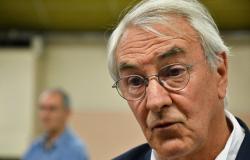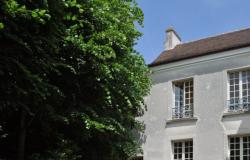
Roubaix (North), special correspondent.
The Roubaisians came in large numbers. This June 21, many are crowding around the central pool of the Swimming Pool. Others, in the old cabins on the first floor. Everyone came to witness the departure of Bruno Gaudichon, who inaugurates the summer exhibitions, the last of his mandate.
The emotion is palpable. Gaudichon thanks everyone who made this crazy project possible. “The spirit of the Pool is strong, rich and important, but it is under threat. I would like to tell you this before I leave. To think, for my generation, that Vichy would return was an unimaginable thing. Without wanting to order you, and if you allow it, don’t leave us in the dark, in ten days. »
It’s rubbish in the text. Don’t leave us in the lurch. But it also works in French. Thunderous applause. “Thank you Bruno! » can we read on a banner surrounded by hearts displayed by the staff.
Reception agents recruited from among the laid-off Lainière workers
1990. The municipality (right) and the management of French museums validate the project for a museum of Art and Industry. Roubaix is no longer the textile capital. There has been no municipal museum since the Liberation. And the municipal swimming pool, the flagship of Art Deco, built in the 1930s under the roof of Jean-Baptiste Lebas, socialist mayor of Roubaix and Minister of Labor of the Popular Front, also closed in 1985, for security reasons.
When Bruno Gaudichon is approached to become the curator of a museum that does not yet exist, he visits a few empty places: a university residence, a nightclub, an exotic aviary… Gaudichon falls in love with this swimming pool, including the 50-metre pool, entirely covered in mosaics, is overlooked by stained glass windows which make the sun’s rays dance. A call for projects was launched and the architect Jean-Paul Philippon was chosen.
On October 20, 2001, the Swimming Pool Museum was inaugurated. Bruno Gaudichon never doubted its feasibility. He believed in it, not as a believer but as a practitioner of popular education driven by the desire to share with as many people as possible the beauty of a painting, the mystery of a sculpture, the emotion of a work of art. ‘art.
He sets up a “public service” and decides to work hard towards the youngest: “The swimming pool had marked the history of the city. All Roubais residents had frequented it and it was anchored in the collective memory. » The first generation of museum reception staff was largely recruited from among workers made redundant from Lainière and a few former employees of the municipal swimming pool. “A few months before the inauguration, the construction site was behind schedule. The agents monitored the site during the day and, every evening, they stayed by our side while we hung the exhibitions for the big day.” It had become their museum.
The heady smell of chlorine that still floated in the buildings in the early days has finally evaporated. When you stroll among the statues lined up along the pool, a soundtrack plays at regular intervals the joyful hubbub of children jumping into the water. Proust and his madeleine…
More than 200,000 visitors per year, including 20% from Roubais residents
Since its opening, the Roubaix Swimming Pool, with an impressive fund funded both by public authorities and by donations, has organized hundreds of exhibitions. Bruno Gaudichon combined excellence, demand and popularity. Roubais residents massively frequent the swimming pool. They feel good there.
There we come across clusters of children, families, amateurs and neophytes. The Little Chatelaine, of Claudel, challenges with his mutinous gaze the man in the overcoat, by Jean Lambert-Rucki; the ceramics on display make you cringe. It is impossible to list all the exhibitions concocted by Bruno Gaudichon.
Chagall, Gromaire, Mahjoub Ben Bella, Jeanne Poupelet, themes such as “work, struggle and passions”, “Beautiful leaves and small papers”, “Crossing the light”, Algeria, by Gustave Guillaumet, or “the Work in the World”, by Di Rosa… Gaudichon remembers the exhibition “Still life”, dedicated to Robert de Niro father, inaugurated in 2005 in the presence of his actor son, who came with his entire family. “The atmosphere was as excited as in front of the red carpet at the Cannes Film Festival,” remembers our curator, still amused.
Gaudichon’s mission was to build “a solidarity museum, a local public service” on the basis of a daring scientific project. “The objective was to welcome 60,000 visitors per year. In the first year, we reached the milestone of 100,000 visitors. There are now more than 200,000 per year, including 20% of Roubais residents, who use the swimming pool. » Mission accomplished.
“I will finally be able to finish a book on Camille Claudel. I am convinced that we can recreate an ecosystem around textiles in Roubaix. I am available for the city’s Secours populaire with whom we have always worked. » He is now officially responsible for imagining the future extension of the museum.
To find out about this summer’s exhibitions, click here
Faced with the extreme right, don’t give up!
It is step by step, argument against argument that we must fight the extreme right. This is what we try to do every day in Humanity.
Faced with incessant attacks from racists and hate mongers: support us! Together, let’s bring another voice to this increasingly nauseating public debate.
I want to know more.





